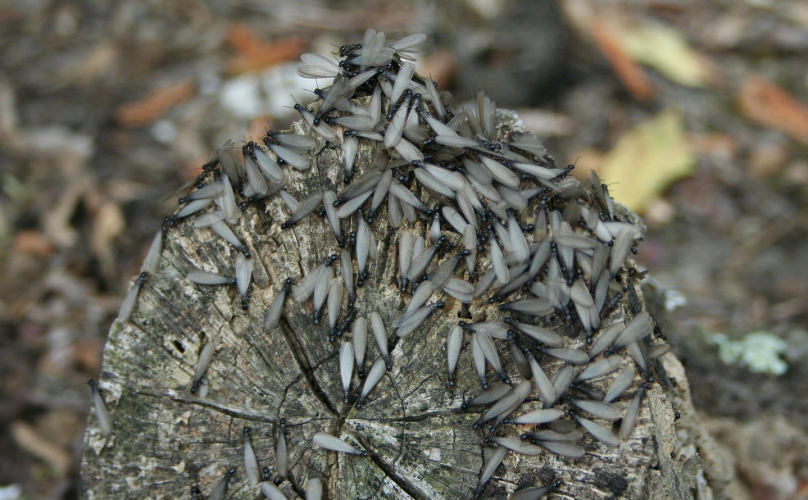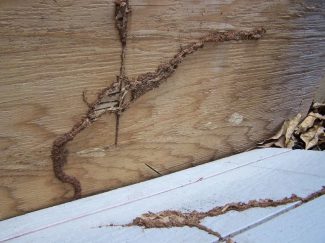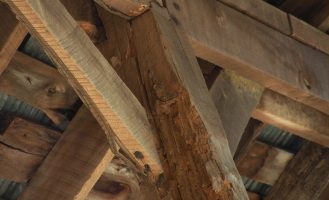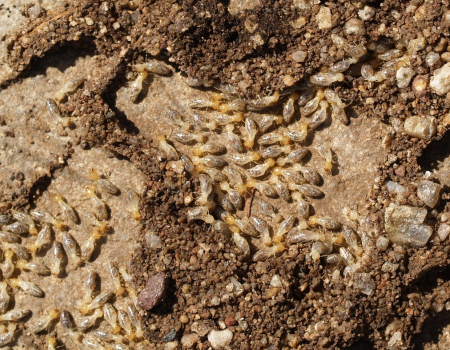By now it should be clear that finding signs of a termite infestation inside the home should result in calling your local pest management professional. Being silent destroyers paired with their ability to chew through structures, it is no wonder termites are a homeowner’s nightmare. But what do you do if you find these destructive pests in your yard or garden? While it may not mean they have infested your home, it does indicate their presence nearby. So let’s look at what it means and what to do if you find termites on your outdoor property.

Signs of Infestation
First of all, if you find termites in your yard or garden, don’t panic but do be vigilant. While finding termites outside is very common, you should still check your property for signs of infestation. Termites are able to travel through various means and, depending on the species, sometimes up to thousands of feet from their nest. The ability to travel such distances means that it is entirely possible for them to reach your home. In the home or in your yard, the signs of infestation are the same, but make sure to check these specific locations.
- Mud tubes – Mud tubes (galleries) are tunnels made of soil, chewed up wood, and termite saliva. These tunnels shelter and protect the termites as they travel between their nest and found source. You may find these mud tubes along the foundation of your home, tree trunks, or any other wood structures in your yard.
- Discarded wings – When they’re ready, reproductive winged termites (alates or swarmers) leave their nests to mate and establish new colonies. After the swarmers find a suitable mate and location, they shed their wings. You can find these discarded wings near window sills, outdoor lights, or other entry points to your home.

- Wood damage – Since termites feed on cellulose-rich materials, it is entirely possible for them to cause damage to other wood structures in your yard. Keep an eye out for sagging wooden structures, wood furniture with blistered or cracked paint, or tree stumps with extensive tunneling.
- Termite swarms – Witnessing a termite swarm anywhere near your property (indoors or outdoors) can be a clear indication of a nearby infestation. If you notice winged termites flying in a concentrated area, take action immediately.

So What Should You Do (or not do)?
If you find termites in your yard there are a few things you should absolutely do, and a few you should avoid.
✅ Do contact your local pest management professional – If you have an active infestation, your PMP can recommend the best and most effective course of action. If not, they can advise you on preventative measures to reduce chances and protect your home from future infestations. In any case, a trained pest professional is your best option to assess, identify, and if needed, handle the situation.
❌ Don’t wait/ ignore the problem – To avoid costly repairs, don’t wait until you suspect the presence of termites in or around the home. Inspect both inside the home and around your yard for signs of infestation. If you notice any of the signs, don’t ignore them and act immediately. Immediate action will help prevent any further damage.
✅ Do inspect your home – Termites in the yard may become termites in the home. Thoroughly inspect your property for mud tubes, discarded wings, or frass, and check for damaged or hollow-sounding wood. If you find any of these signs inside your home, contact a pest management professional right away.
❌ Don’t attempt any DIY treatments – DIY treatments, home remedies, and insect sprays are often ineffective for long-term termite elimination. These treatments may only provide instant or temporary relief. As a result the infestation may continue to grow undetected and ultimately, cause more serious damage.
✅ Do clear any debris or fallen branches from your yard – Wood debris, fallen branches, spare cardboard, and old wood piles. All of these can serve as a food source for termites and draw them closer to your home. Either remove them completely, or, if necessary, store them off the ground, a few yards from the perimeter.
❌ Don’t disturb the termites – Avoid disrupting termite mud tubes or nests. Any disturbances may cause them to relocate to a different area of your property or worse, inside your home. Potential relocation can make control and elimination more challenging.
How To Prevent Termites
So, if you find termites in your yard or garden, first contact your local pest management professional. A professional will be able to identify the termite species and assess the extent of an infestation. Proper identification is essential because different species may require different treatment approaches. Once identified and assessed, your PMP can help develop a customized treatment strategy based on the termite species, infestation level, and your property.
More importantly, if the infestation has reached your home, a professional can help eliminate the problem as quickly as possible.
Additionally, seeking the help of a professional pest control company will ensure the infestation is treated with high-quality products and equipment. These products are more potent and effective in treating termite infestations. Following initial treatment, pest professionals will with follow-up treatments and maintenance to eliminate the current infestation and prevent future ones.

If you own or work for a pest control company and would like to try out MABI injectors, contact one of our distributors.